This was published 4 years ago
Looking for the exotic India? Rajasthan offers plenty of romance
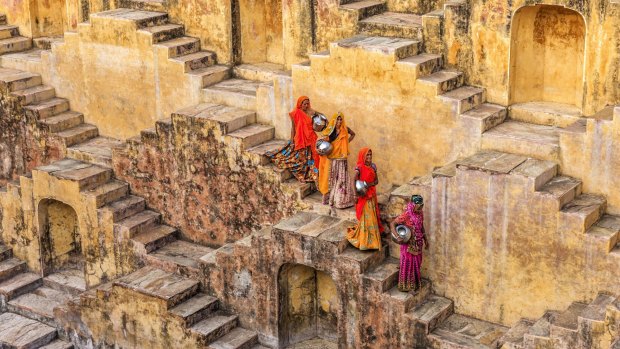
Women gathering water from a stepwell in Amer, near Jaipur,Credit: Getty Images
"And this," says the jeweller as he fastens the necklace around my wife's neck, "was a necklace that Shah Jahan gave to Mumtaz." As in Shah Jahan, who built the Taj Mahal for his wife Mumtaz, almost 400 years ago.
Around Liz's neck is a circlet of pearls set in gold links, descending to an emerald the size of a small chicken's egg. It's museum-quality jewellery, fabulous beyond words, and although our friendly jeweller is probably telling porkies, we're going along with it. Keeping Mumtaz you might say, although the wondrous necklace and Liz's neck soon part company.
We're on a trip through the Indian state of Rajasthan, and although Agra lies in a different state, by default the home of the Taj Mahal is included in any tour of Rajasthan.
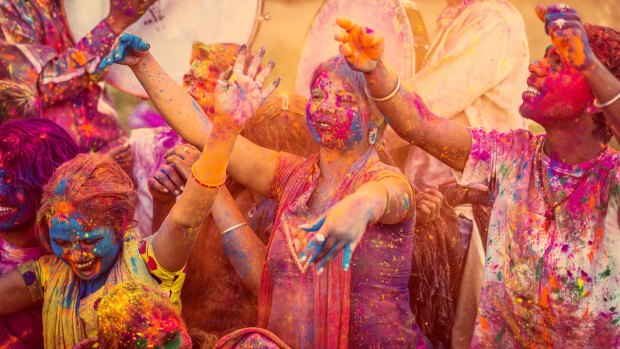
Vivid colours of the Holi Festival.Credit: Getty Images
One of the new Seven Wonders of the World, the tomb that Shah Jahan built for his beloved wife is poetry in stone, colossal yet ethereal. It's even more so if you happen to catch it by moonlight; the grounds of the Taj are open for night viewing on five nights around the time of the full moon.
In the country's north-west, Rajasthan, "land of kings", is India's largest state, semi-desert for the most part, bisected by the sunburned Aravalli Hills. It draws more visitors than any other part of the country and the reason is romance.
If you're looking for the exotic version of India, complete with desert forts, peacocks, princely palaces, tigers, painted elephants, men in turbans and women with mirror-embroidered saris that flash when they walk, Rajasthan delivers in spades.
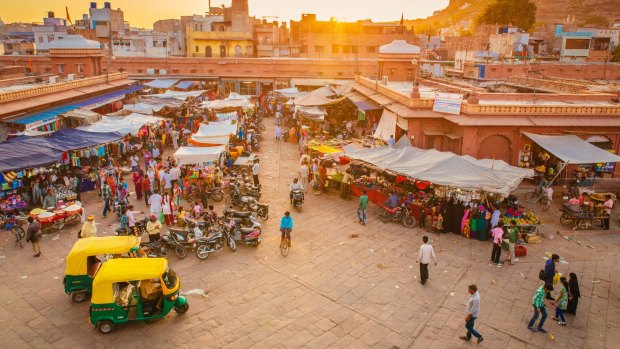
A typically busy market in Jodhpur’s Old City.Credit: Getty Images
For most travellers, Jaipur is the gateway to Rajasthan. The city sits at the southern apex of India's so-called "golden triangle" – Delhi, Agra and Jaipur. Known as "the pink city" (in reality, it's more terracotta than pink) after it was painted to commemorate a visit by the Prince of Wales in the late 1800s, Jaipur was established by one of the bluest bloodlines of the Rajput royal families and it comes with regal upholstery.
There's a pretty water palace casting its reflection across Man Singh Lake, the monumental Amber Fort just outside the city, a glittering City Palace and a famous facade in the Palace of the Winds, a five-storey ochre honeycomb from which the palace's women could see without being seen.
Jaipur is also a place made for strolling. The verandahs that line the central boulevards within the city walls are broad and mostly uncluttered, and ideal for taking in the sari merchants, tailors, bangle makers and samosa makers who ply their trade from open-fronted shops.
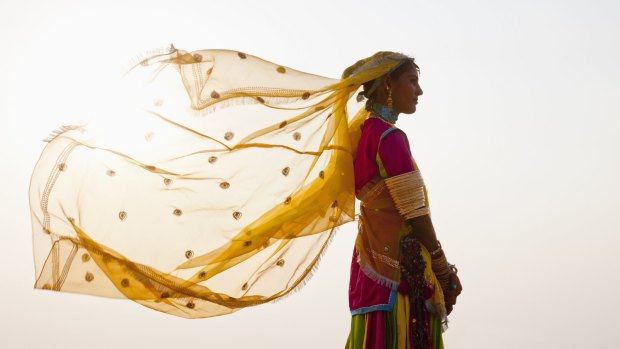
Colourful clothes and flowing headwear of a Rajasthan village woman.Credit: Getty Images
Jaipur is also one of the best places to experience one of India's palace hotels. When the maharajas were shorn of their estates after independence, the whole country was littered with princely piles that required only a reception desk and extra plumbing to transform a harem into a hotel.
Jaipur's Suján Rajmahal Palace Hotel is one of the prettiest hotels you'll ever see. Built in 1729 for the ruling family of Jaipur and restyled by Adil Ahmad, darling of Delhi's modern rococco designers, the look is straight out of the Marie Antoinette playbook.
The suites are vast, elegant and gaspingly gorgeous. The Royal Suites are named after a famous person who's slept in them – Jackie Kennedy, Louis Mountbatten, Queen Elizabeth – and furnished with mementos of each.
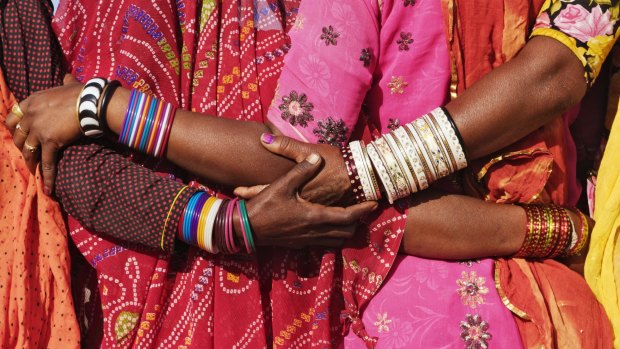
Embroidered saris and bangles, traditional dress for married women in Rajasthan.Credit: Getty Images
Most travellers will get no deeper into Rajasthan than Jaipur, but to experience the real Rajasthan you need to head further south and west, to the former princely states of Mewar and Marwar.
Marwar's capital, Jodhpur, is one of the state's most manageable and likeable cities, crowned by the vast and impressive Mehrangarh Fort, its cliff-like walls radiating military might and purpose.
In contrast to the formidable exterior, the interior is a jewel box, a succession of cloistered courtyards where the women of the former harem observed the world from behind filigree screens.
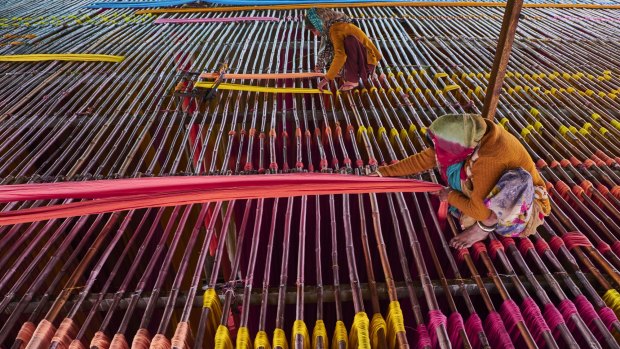
Hanging textiles to dry on bamboo rods in a sari factory.Credit: Getty Images
Pavilions set within walled gardens and the richly ornamented chambers of the former royal suites complete the bedazzlement.
Jodhpur is known as the "Blue City", and essential to the experience is a stroll through the labyrinthine corridors just below the fort, where the upper-caste Hindus who inhabit the area daub the walls of their houses with indigo paint.
While Jodhpur has its fair share of palace hotels, Raas Jodhpur injects hipster style into the city's hotel scene. Set behind studded gates close to the main bazaar, the architecture blends the flowery exultations of the former merchant's house with a modernist wing behind slit jaali screens.
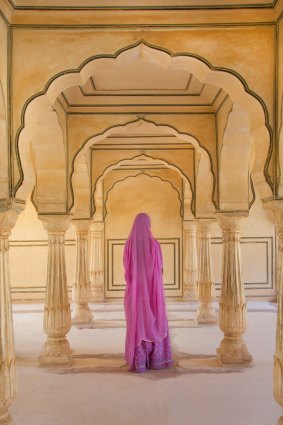
A saried princess stalks the audience hall at Amber Fort, Jaipur.Credit: Getty Images
The effect verges on blockhouse-modern but inside each room is a miracle of crisp comfort. An infinity pool sits within Mughal-style gardens that lie like a prayer carpet, rising to the brooding mass of Mehrangarh Fort.
The heart and soul of India lies in its villages, and to the south of Jodhpur, Narlai is a sublime and exotic corner in one of the most colourful parts of India.
At the heart of the village, set against an elephantine hump of granite studded with temples, Rawla Narlai is a former country retreat that belongs to the Jodhpur royal family and is now a gorgeous heritage hotel of great character.
Stucco walls in faded citrus and vanilla surround three bougainvillea-wrapped courtyards, one with a big swimming pool. Guest rooms in the zenana, the women's quarter, have decorated walls and ceilings and gorgeous filigree architecture.
There's a full-fledged activity program here that includes leopard safaris, birdwatching and guided walks through the village in the company of a traditional Rabari herdsman wearing an enormous scarlet turban.
Every night the hotel organises dinner at a stepwell on the outskirts of the village, lit by a thousand flickering oil lamps and serenaded by a man playing sacred music on a veena.
Close by, Ranakpur is the site of a 15th-century Jain temple festooned with domes and cupolas and an interior decorated like an exotic cave, with stalactites and stalagmites of white marble, every centimetre carved as delicately as lacework.
It's been compared with the Taj Mahal but they're as different as the pearls and emerald in Mumtaz Mahal's necklace, but jewels all the same.
This article appears in Sunday Life magazine within the Sun-Herald and the Sunday Age on sale March 1.
Sign up for the Traveller Deals newsletter
Get exclusive travel deals delivered straight to your inbox. Sign up now.